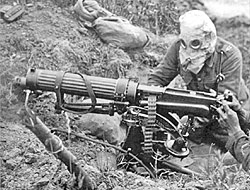
Unit 5: Crisis and Change
Lesson D: Postwar Anxiety, Creativity, and Change
Lesson Overview

Vickers Machine Gun Crew with Gas Masks [1]
The First World War was a key turning point in world history. After the long and horrific conflict ended, many hoped for a lasting peace. World War I devastated Europe. New borders, countries and mandates affected the balance of power in the Middle East and Africa. The war also disrupted the global economy and spread a flu pandemic to regions untouched by the fighting. Nearly an entire generation of young men had perished in the trenches, and millions of civilians had succumbed to famine, flu, and the horrors of modern war.
The Treaty of Versailles and other major political negotiations left some countries richer and others poorer than they had been before the Great War. Traditional social patterns were disrupted, and young people, especially women, adopted new values and sought to have more influence on their lives and the world around them.
The war brought changes in technology, particularly in transportation and communication. Artists, writers, and musicians broke with the past, too. Some expressed their disillusionment, or disappointment, with post-war society. Others experimented with new styles in search of meaning in an uncertain, anxious world.
Key Questions
- How did World War I affect the women's suffrage movement?
- How did World War I affect literature and the visual arts?
- What were the global social, political, and economic effects of the media during this time period?
- What were the effects of the 1918 influenza pandemic?
Student Outcomes
- Examine the global impact of the 1918 influenza pandemic.
- Explain the impact of World War I on the women's suffrage movement worldwide.
- Evaluate the impact of jazz, literary movements, and artistic movements such as Cubism, Surrealism, Expressionism, Realism on culture.
- Describe the impact of African and Asian art forms on European art.
- Analyze how new media, such as newspapers, magazines, commercial advertising, film, and radio contributed to the rise of mass culture and interactions around the world.
- Obtain historical data from a variety of sources. (Historical Thinking Skill)
- Analyze cause-and-effect relationships and multiple causation, including the importance of the individual and the influence of ideas. (Historical Thinking Skill)
Key Terms
Student Resources
- Consumers and the Media in the 1920s (doc)
- Transformations in 1920s Society Brief Constructed Response (BCR) (doc)
Chart of Activities:
| Activities to Complete | Estimated Time |
|---|---|
| Pre-Assessment | 10 minutes |
| Key Terms | 5 minutes |
| Activator: The World 1918 -1929 | 15 minutes |
| Activity 1: Global Influenza Pandemic World Map | 10 minutes |
| Activity 2: Global Influenza Pandemic | 20 minutes |
| Activity 3: Consumers and the Media in the 1920s | 15 minutes |
| Activity 4: The Impact of WWI on Music, Literature, and Arts | 10 minutes |
| Activity 5: The Impact of WWI on Music, Literature, and Arts Discussion | 15 minutes |
| Activity 6: Women's Lives Change After WWI ñ Equal Rights | 20 minutes |
| Activity 7: Women's Suffrage Timeline | 10 minutes |
| Activity 8: Women's Suffrage Historical Opposition | 15 minutes |
| Activity 9: Women's Suffrage Timeline Review | 5 minutes |
| Review and Assessment | 20 minutes |
| Lesson Summary | 5 minutes |
Lesson Completion Time
The total estimated time to complete this lesson is 175 minutes.
Page Notes:
[1] Source: This image from http://en.wikipedia.org/wiki/File:WW1_TitlePicture_For_Wikipedia_Article.jpg is in the public domain because its copyright has expired.

